9 Tips for Decorating Wooden Walls
Wooden houses are an example of environmental friendliness and naturalness, and when facing it is important not to negate this is their main advantage, therefore it is important to involve only professionals in the finishing work, use only high-quality breathing materials. Let's try to deal with all the nuances of wall decoration in a wooden house and consider what materials are suitable for their cladding, and when you can do without them.
No. 1. When can I start decorating wooden walls?
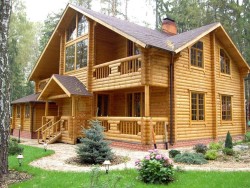 Alas, immediately after the construction of the wooden house go to finishing work not allowed. A newly built house needs to be given shrink time. Duration of this process depends on many factors. If the house is built of glued timberthen you can proceed to wall decoration through 3-4 weeksand the owners of all other types of wooden houses will have to wait not less than 10 months, and for a guarantee - a year. The shrinkage time depends not only on the material used in the construction, but also on the climatic conditions in the region and the initial moisture content of the raw materials.
Alas, immediately after the construction of the wooden house go to finishing work not allowed. A newly built house needs to be given shrink time. Duration of this process depends on many factors. If the house is built of glued timberthen you can proceed to wall decoration through 3-4 weeksand the owners of all other types of wooden houses will have to wait not less than 10 months, and for a guarantee - a year. The shrinkage time depends not only on the material used in the construction, but also on the climatic conditions in the region and the initial moisture content of the raw materials.
During shrinkage, wood is actively dried, it is reduced in size, and used insulation dying under the weight of logs and timber. It is easy to imagine what will happen if you start decorating the walls during this period - the facing material will either fall off or distort it. In any case, after a few months, everything will have to be redone, and this again is money and effort, so it’s better to wait until the main shrinkage processes have passed. But you won’t be bored with nothing, since it is at this time that it is necessary to ensure the tightness of all joints, which is achieved through competent cannabis.
No. 2. Features caulking walls of a wooden house
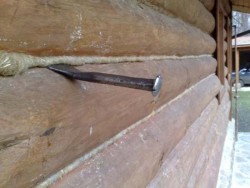 Caulking is carried out in two stages: the first time a few months after the construction of the house, the second time - after 6-8 months. The essence of the process is to fill the gaps insulationusually used as jute or tow. The quality of the performance of these works depends home insulation and its tightness.
Caulking is carried out in two stages: the first time a few months after the construction of the house, the second time - after 6-8 months. The essence of the process is to fill the gaps insulationusually used as jute or tow. The quality of the performance of these works depends home insulation and its tightness.
Caulking is carried out immediately inside and out, bypassing the house around the perimeter and pumping each crown from bottom to top. Each time after this, the structure will rise by 5-7 cm, and then settle, sealing the insulation, which will completely fill the cracks. Finishing work can only proceed when shrinkage occurs after the second caulk. To Know exactly when it is already possible to carry out the facing, it will be necessary to regularly measure the height of the walls: if within 2-3 months the obtained values are practically unchanged, then the main shrinkage processes have passed, and you can proceed to the finish. The next time caulking is carried out after 5 years, and then if necessary.
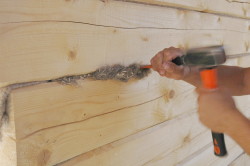 Caulking is performed in one of the following ways:
Caulking is performed in one of the following ways:
- "To set." First, long thin strands are made of insulation material, and then they are wound into a ball. Slots are filled with such strands, and the larger the gap, the more strands will be needed;
- "Stretching". This method involves the use of individual strands, which fill the cracks. A roller is formed from them, which is pushed into the gap.
To perform caulking you need a simple set of tools: hammer, chisels, rubber mallet and hoe.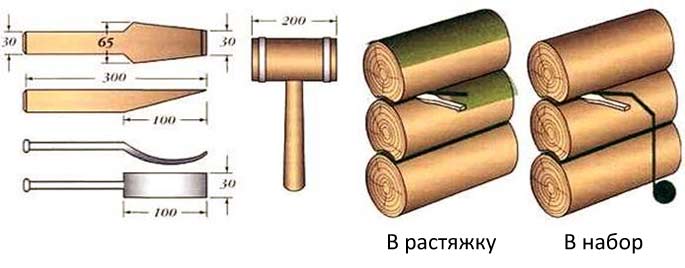
No. 3. The nuances of choosing a finishing material for wooden walls
A distinctive feature of wooden walls is the ability to maintain optimal temperature conditions and humidity levels indoors. To preserve these unique properties, cladding is necessary use natural materials. The choice of a specific material is affected mass of factors:
 climate of the region and whether the homeowners will be live in it constantly or only in the summer. If the climate is mild or it is supposed to rest in a wooden house only in the warm season, then you can do without additional finishing materials and admire the natural beauty of the log house, however, do not forget to cover it protective equipment. If the house will be used constantly, and the winters in the region are cold, then it is better to use the finish, and install it on the crate, in order to use insulation in the interval between the wall and the lining;
climate of the region and whether the homeowners will be live in it constantly or only in the summer. If the climate is mild or it is supposed to rest in a wooden house only in the warm season, then you can do without additional finishing materials and admire the natural beauty of the log house, however, do not forget to cover it protective equipment. If the house will be used constantly, and the winters in the region are cold, then it is better to use the finish, and install it on the crate, in order to use insulation in the interval between the wall and the lining; condition of the house. The walls of the new wooden house are distinguished by their attractive appearance, beautiful texture and color, so if possible they should not be hidden under the finish. In this case, it is better to grind the log or timber and to tint the surface. Used for this water based paintsthat do not paint over the color of the wood, but only give it a certain shade, or tinting antiseptics. Antiseptics will still have to be used to preserve the original appearance of the wood for a long time and provide it with reliable protection. Varnish can also be used, but more often they cover the floors. If the walls are old and already have an imperfect appearance, then it is better to hide them under the finish. Great for lining, in particular the one that imitates log cabin - block house;
condition of the house. The walls of the new wooden house are distinguished by their attractive appearance, beautiful texture and color, so if possible they should not be hidden under the finish. In this case, it is better to grind the log or timber and to tint the surface. Used for this water based paintsthat do not paint over the color of the wood, but only give it a certain shade, or tinting antiseptics. Antiseptics will still have to be used to preserve the original appearance of the wood for a long time and provide it with reliable protection. Varnish can also be used, but more often they cover the floors. If the walls are old and already have an imperfect appearance, then it is better to hide them under the finish. Great for lining, in particular the one that imitates log cabin - block house;- features of the room. In some rooms, wooden walls can be covered with tiles, plaster, or even drywall and siding. Of course, this is justified only for kitchens and bathsto provide maximum protection to the wood.
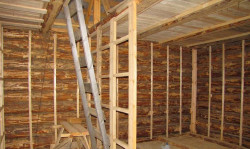 Clapboard, drywall, wall panels and many other finishing materials are attached to the wooden walls with crates, it is better to perform from a wooden beam. If necessary, lay in the crate insulationbut if the house is not cold and on heating a little money is spent, it is better to do without additional thermal insulation and vapor barrier, because the wood itself copes with these tasks, and excess materials can only upset the natural balance. It’s better to leave a space between the wall and the cladding, providing normal air circulation, which is very important to prevent rotting wood. The resulting clearance for the finishing material can be used to communication organizationincluding electrical wiring. When it comes to wooden walls, electrical cables need to be laid in non-combustible pipes, so space is required decently.
Clapboard, drywall, wall panels and many other finishing materials are attached to the wooden walls with crates, it is better to perform from a wooden beam. If necessary, lay in the crate insulationbut if the house is not cold and on heating a little money is spent, it is better to do without additional thermal insulation and vapor barrier, because the wood itself copes with these tasks, and excess materials can only upset the natural balance. It’s better to leave a space between the wall and the cladding, providing normal air circulation, which is very important to prevent rotting wood. The resulting clearance for the finishing material can be used to communication organizationincluding electrical wiring. When it comes to wooden walls, electrical cables need to be laid in non-combustible pipes, so space is required decently.
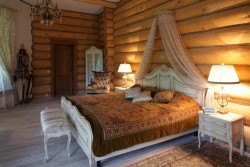 Despite what material will be selected for installation on the crate, you must leave clearance to the ceiling 2-4 cm. If the house was recently erected, it will become insurance against shrinkage, and for an old wooden house - in case of changes in the geometry of the wood, because this material absorbs moisture and gives it away during the entire period of operation. The gap will allow the wood to breathe calmly without disturbing the lining. So that this safety distance is not replaced, the baseboard is attached only to the surface of the ceiling, and leaned against the wall.
Despite what material will be selected for installation on the crate, you must leave clearance to the ceiling 2-4 cm. If the house was recently erected, it will become insurance against shrinkage, and for an old wooden house - in case of changes in the geometry of the wood, because this material absorbs moisture and gives it away during the entire period of operation. The gap will allow the wood to breathe calmly without disturbing the lining. So that this safety distance is not replaced, the baseboard is attached only to the surface of the ceiling, and leaned against the wall.
Number 4. Painting or varnishing
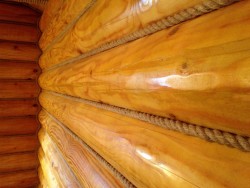 If possible, it is better to leave the wooden walls inside without finishing, because they already have an excellent appearance - without special need it is better not to spoil it, but only emphasize it. For these purposes can be used paints, antiseptics and varnishes. Spoil the result can only not very aesthetic cannabis stitches, but there is a way out for this case too - they can be seal with a twisted cord. It turns out very original and cute, and the cord will also serve as additional protection against drafts.
If possible, it is better to leave the wooden walls inside without finishing, because they already have an excellent appearance - without special need it is better not to spoil it, but only emphasize it. For these purposes can be used paints, antiseptics and varnishes. Spoil the result can only not very aesthetic cannabis stitches, but there is a way out for this case too - they can be seal with a twisted cord. It turns out very original and cute, and the cord will also serve as additional protection against drafts.
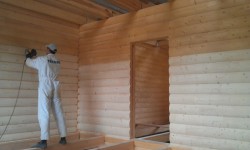 Before varnished or beauty is important prepare the walls correctly. First stage - grinding. Many are afraid of this process, being afraid to violate the natural texture of the tree, but if everything is done correctly, the appearance of the walls will only get better. Grinding helps to get rid of cracks that may have occurred as a result of shrinkage. After this, processing antisepticsthat prevent the appearance of fungus and mold, and film-forming compounds (varnishes and oils), which create a reliable protective layer on the wood surface, protecting the material from dirt, darkening and mechanical influences. It is also advisable to use flame retardants - substances that increase the resistance of wood to fire.
Before varnished or beauty is important prepare the walls correctly. First stage - grinding. Many are afraid of this process, being afraid to violate the natural texture of the tree, but if everything is done correctly, the appearance of the walls will only get better. Grinding helps to get rid of cracks that may have occurred as a result of shrinkage. After this, processing antisepticsthat prevent the appearance of fungus and mold, and film-forming compounds (varnishes and oils), which create a reliable protective layer on the wood surface, protecting the material from dirt, darkening and mechanical influences. It is also advisable to use flame retardants - substances that increase the resistance of wood to fire.
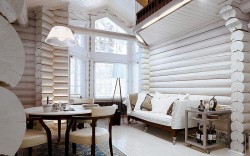 Paint may be glazed or tinted. The first option is used when it is necessary to preserve the natural color of wood, but give it a certain shade. Paints with a dense color tint completely cover the color of the tree, but before painting the entire wall or part of it, it is better to try to apply the material to an inconspicuous part of the wall. If it is necessary to hide the topography of the tree, then a primer is used for painting.
Paint may be glazed or tinted. The first option is used when it is necessary to preserve the natural color of wood, but give it a certain shade. Paints with a dense color tint completely cover the color of the tree, but before painting the entire wall or part of it, it is better to try to apply the material to an inconspicuous part of the wall. If it is necessary to hide the topography of the tree, then a primer is used for painting.
Most often for painting wooden walls, the following compositions are used:
 water based acrylic paints - perfect option. These are safe and environmentally friendly materials that form an elastic, durable coating that allows the wood to “breathe”. The structure can be transparent and dense. The disadvantage is the high price;
water based acrylic paints - perfect option. These are safe and environmentally friendly materials that form an elastic, durable coating that allows the wood to “breathe”. The structure can be transparent and dense. The disadvantage is the high price;- alkyd paint allows wood to provide additional protection against fungus and moisture. The material is resistant to temperature extremes and frosts, is inexpensive, but such a coating dries for about a day, and then an unpleasant odor can remain for several days;
- oil paints less and less used for decorating wooden walls. They are well absorbed into the tree, due to which it receives additional protection against moisture and dirt. The coating is safe, has a mass of saturated shades, but dries for about three days, and may turn yellow over time.
Using nitro paints and polyurethane paints is strictly not recommended - they violate the environmental friendliness of wood.
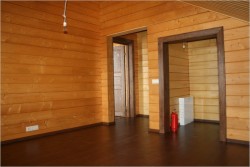 Alternative to paint - varnishes. They have a transparent structure and do not hide the natural beauty of the tree, but now there are also tinting varnishes on sale that can slightly change the shade of the tree. According to the type of surface obtained, varnishes are divided into matte and glossy - there is someone like it. If necessary, clear varnish can be tinted. Another good option is wax, it allows you to get a velvety coating with a gloss.
Alternative to paint - varnishes. They have a transparent structure and do not hide the natural beauty of the tree, but now there are also tinting varnishes on sale that can slightly change the shade of the tree. According to the type of surface obtained, varnishes are divided into matte and glossy - there is someone like it. If necessary, clear varnish can be tinted. Another good option is wax, it allows you to get a velvety coating with a gloss.
All described coating options can be used and for decorating lining. Do not forget that it is necessary to process wood with protective agents if you will use a lathing and facing material.
No. 5. Lining for the decoration of wooden walls
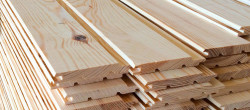 Most often for the design of wooden walls use lining - a completely natural material, a kind of cladding board, which is made from different types of wood. Environmental friendliness is not the only advantage of lining. it inexpensive and easy to install material with excellent decorative qualities. Lining, unlike, for example, from drywall, can withstand the load - it will be possible to hang something on it.
Most often for the design of wooden walls use lining - a completely natural material, a kind of cladding board, which is made from different types of wood. Environmental friendliness is not the only advantage of lining. it inexpensive and easy to install material with excellent decorative qualities. Lining, unlike, for example, from drywall, can withstand the load - it will be possible to hang something on it.
For internal wall cladding, you can take the lining 1.5-2 cm thick - She copes with her tasks perfectly, is inexpensive and weighs little. Thicker material will require a powerful crate that takes up a lot of free space. Lining rails can be mounted horizontally, vertically, at an angle or at the same time use different directions, creating beautiful panels.
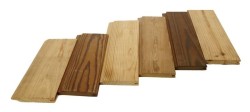 Lining can be made from different wood species, but the tree is pre-dried well (humidity should not exceed 12%). Hardwood (birch, ash, linden) can be used in any premises, including and in the bath (linden, alder), and cheaper conifers only suitable for living rooms, as at high temperatures emit resin. Experts advise, if possible, to select a lining from the breed from which the house was built. In this case, the walls and finishes will have approximately the same expansion coefficients.
Lining can be made from different wood species, but the tree is pre-dried well (humidity should not exceed 12%). Hardwood (birch, ash, linden) can be used in any premises, including and in the bath (linden, alder), and cheaper conifers only suitable for living rooms, as at high temperatures emit resin. Experts advise, if possible, to select a lining from the breed from which the house was built. In this case, the walls and finishes will have approximately the same expansion coefficients.
The lining is made of edged boards - the core boards are less durable and are not suitable in these integers. According to the quality of wood, the lining is divided into such classes:
- extra - material without cracks, knots and other defects, with uniform color;
- class A. One knot or a non-through crack is allowed for every 1.5 linear meters;
- class B - this is a lining, on 1.5 running meters of which there can be 4 knots and 2 resin pockets. The presence of contrasting spots is also allowed;
- class C - This is a lining with a large number of spots of stripes, cracks, tar pockets and knots. For wall cladding is not suitable.

The surface of the lining may be as follows:
- flat. Only such wall paneling was previously sold. It looks good, but to many it may seem boring;
- softline - almost the same flat paneling, but with rounded edges;
- block house - lining, which simulates a log cabin. This is ideal when it is necessary to preserve the style and atmosphere of a wooden house;
- panel - imitation of sawn timber from a log;
- American - a lining with a wedge-shaped profile, due to which the wall will look as if the panels were overlapped.

Before mounting on the crate, the lining of conifers can be demineralized by special means or 25% acetone solution. If necessary, you can lighten contrast bands and spots.
All modern lining has special mountsthat facilitate its installation. Do not forget to leave 2-4 cm gaps above and below to compensate for the expansion of the wood. Used to lining to the crate fastened with nailsthat were driven into the front surface. At best, used the finish nails or nails without caps. Today for installation use klyammery or they drive nails at an angle into a spike or groove.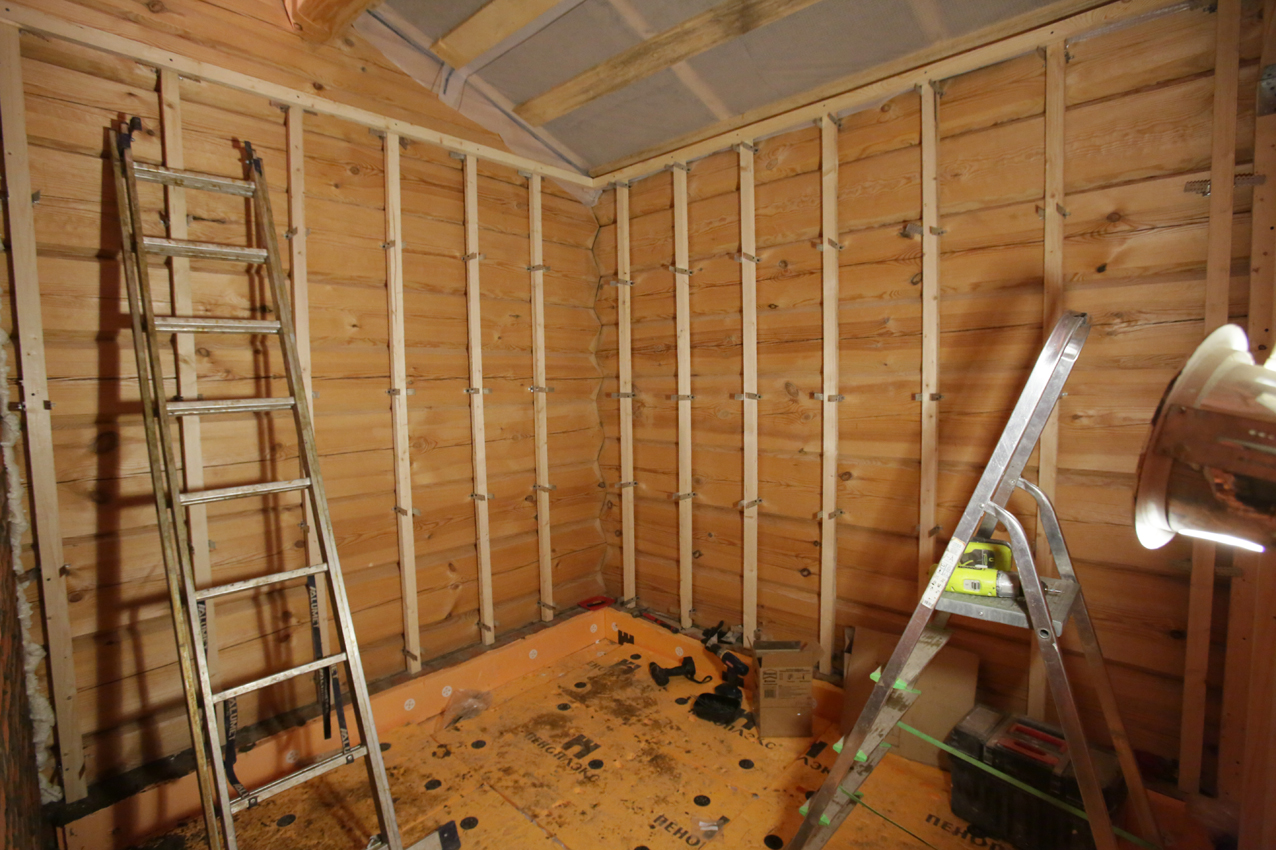
No. 6. Wall panels
Thanks to the use of wall panels, walls can be transformed beyond recognition and to embody absolutely any design idea, with their help they often draw up only separate zones: above the bed, kitchen apron, near the bathroom. Wall panels are made from different materials:
Panels can be typesetting and shield. Typesetting have a long length and a small width, are connected by the principle of a spike groove. Wooden lining, in fact, refers to the shield wall panels, but its wide distribution and unique properties made it possible to distinguish it in a separate class of finishing materials. The panel panels are already more comparable in length and width.
Wall panels are mounted on the crate, the step of which depends on the parameters of the finishing material. The variety of design cannot be described in words, but not all such panels meet the requirement of environmental friendliness: leather and glass will not violate the microclimate, which cannot be said about plastic panels. However, even plastic panelsincluding and plastic lininghave the right to be used to decorate the bathroom, toilet or kitchen.
Number 7. Drywall
Drywall for cladding wooden walls rarely used for obvious reasons. Its use is justified when necessary. erect a partition, hide communications or when the surface of the tree has significant defects. Installation of drywall sheets is carried out on frame, for the construction of which you can use a wooden beam or a metal profile, you can not do without gaps near the ceiling and floor.
Drywall finishing can be done only after complete shrinkage of the house and provided that the room is heated in winter. Gypsum is a sensitive brittle material, which, when shrinking walls or sudden changes in temperature, can be severely deformed. To extend the life of such a finish, you can use floating frameand glue all sheet joints and corners reinforcing polymer mesh. For walls in the kitchen and in the bathroom, you need to use moisture-proof drywall.
Number 8. Stone, tile and plaster
Artificial and natural stone, as well as tiles, are environmentally friendly materials that will not violate the microclimate of a room with wooden walls, but they are rarely used as the main independent cladding. A stone, for example, is suitable for fireplace area, tile will be appropriate for bathrooms and kitchens. By the way, tile and artificial stone can imitate wood so accurately that the appearance of the house will not suffer at all.
Wooden walls plaster also infrequently but separate plaster compositionswhich tolerate the effects of moisture and heat, can be used to design the working area of the kitchen or in the toilet.
No. 9. Features of the interior decoration of old wooden walls
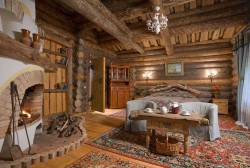 Finishing work in an old house made of timber or log is preceded by the dismantling of the cladding and wood condition assessment. All light and dark spots that differ in texture and structure of the areas must be checked for strength with a chisel, screwdriver or with a knife. If there are no signs of destruction, it remains only to cover the wood with protective compounds and proceed to finishing work.
Finishing work in an old house made of timber or log is preceded by the dismantling of the cladding and wood condition assessment. All light and dark spots that differ in texture and structure of the areas must be checked for strength with a chisel, screwdriver or with a knife. If there are no signs of destruction, it remains only to cover the wood with protective compounds and proceed to finishing work.
When the wood has lost strength in places, crumbles or has dried out, it is better to consult a specialist who will help determine the cause (insects, fungus, microorganisms) and select a set of measures. Most likely, the damaged parts will have to be replaced, paying particular attention to the processing of adjacent areas with antiseptics. After carrying out restoration work, you can proceed to the finish by choosing one of the options listed above. The main advantage in this case is the absence of the need to take into account shrinkage.
Finally
Despite the fact that you can use a variety of materials for cladding wooden walls, it is better to stop the choice on a wooden lining or simply cover the wood with paint or varnish, while maintaining the original color and texture. Try to refrain from the temptation to start finishing before the log house gives the main shrinkage - this saves money and nerves.

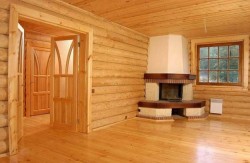
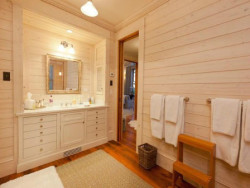
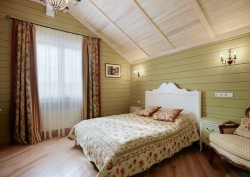
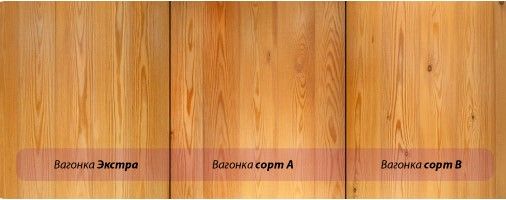

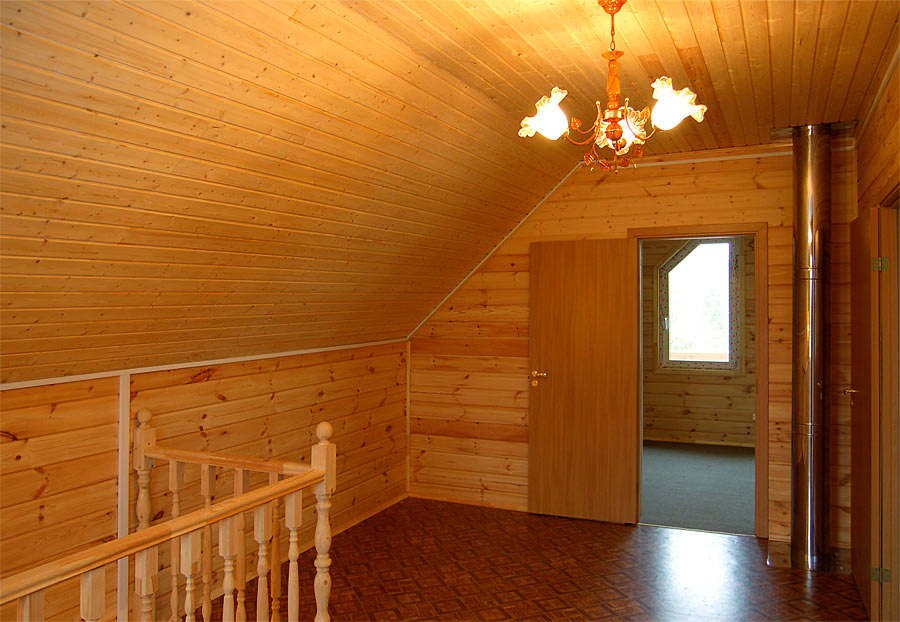
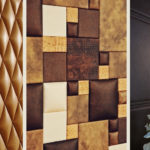
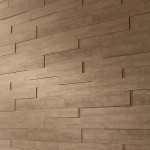
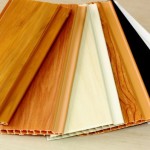
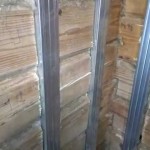
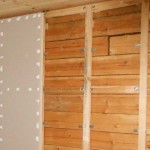
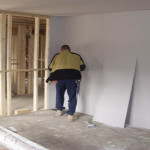
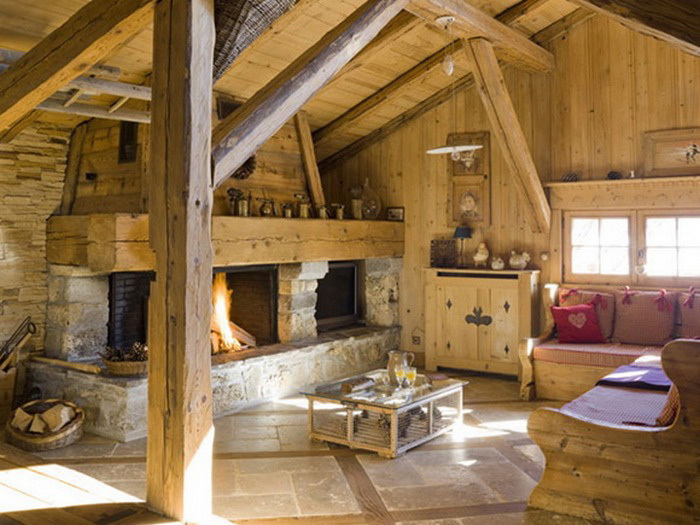
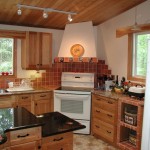
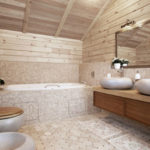
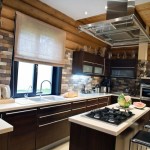
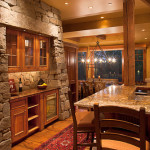
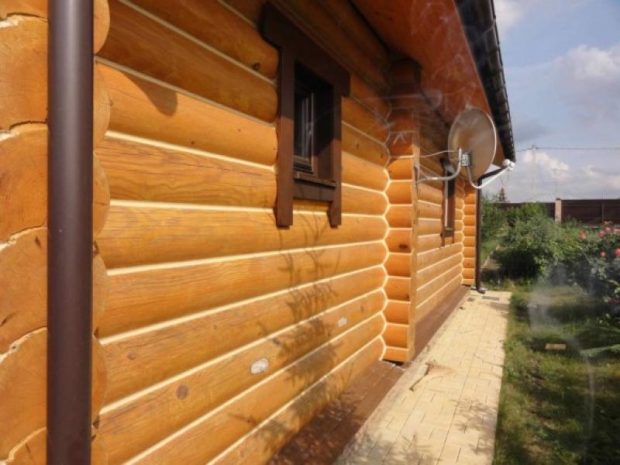

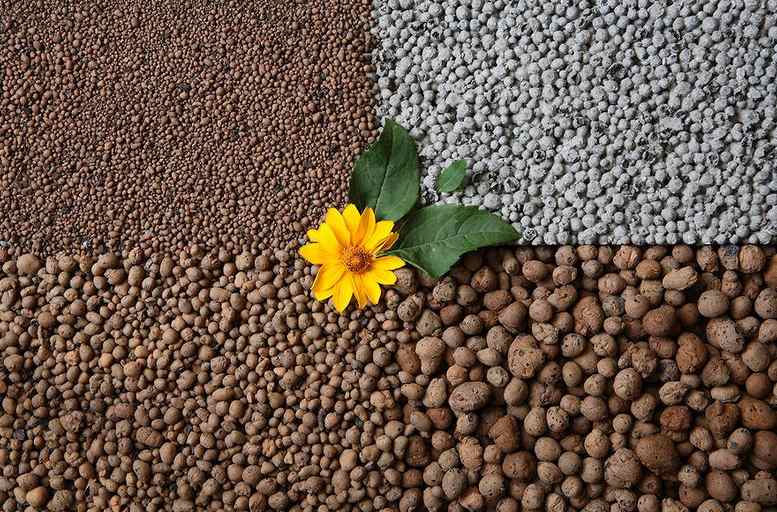
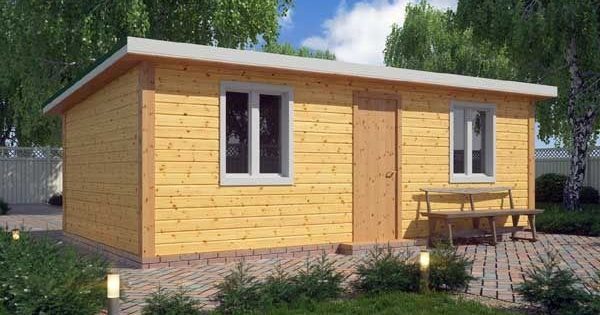

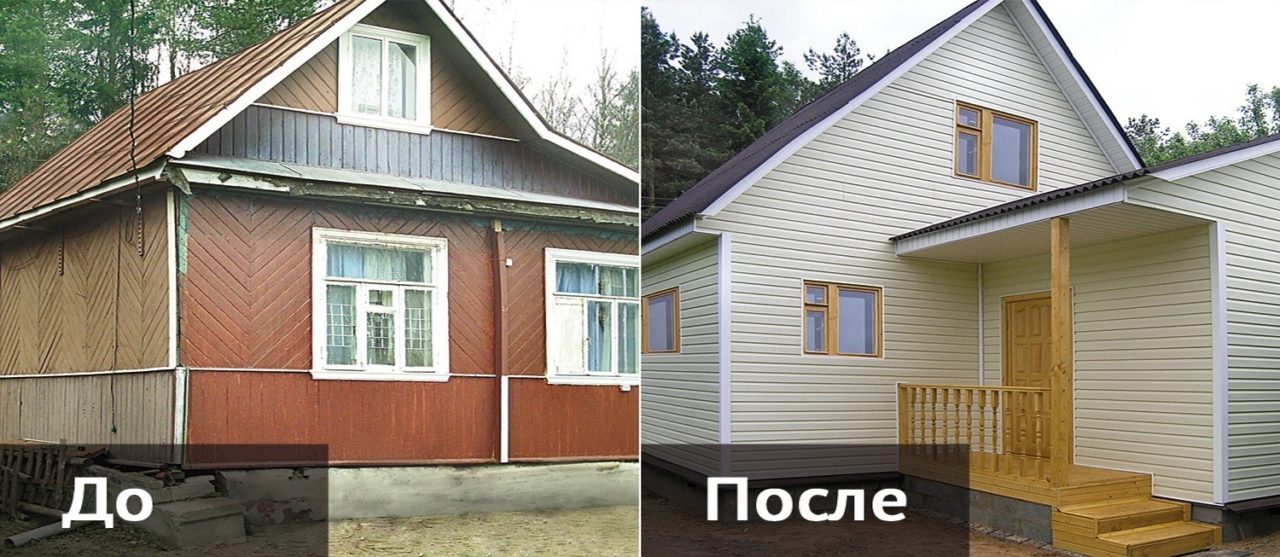

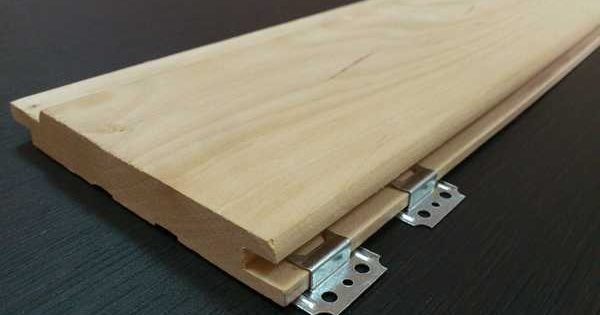

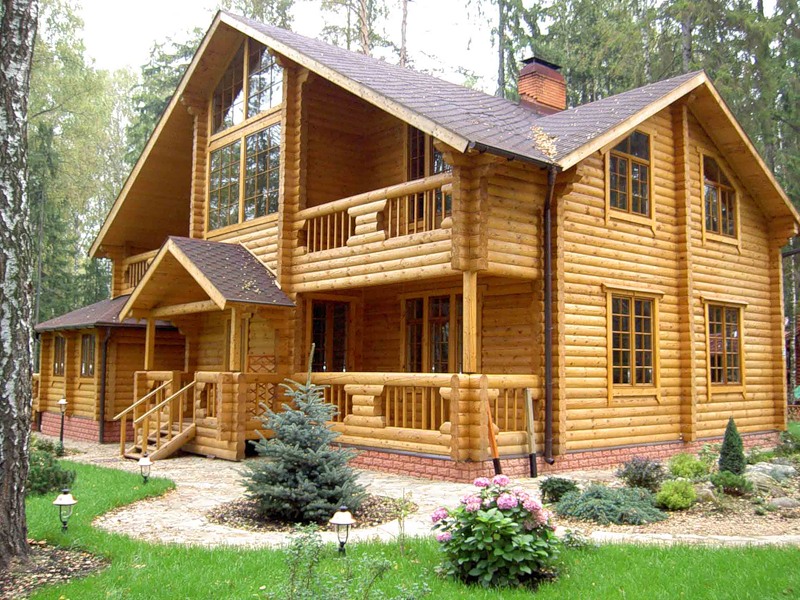
I wonder how to determine if the house has completely shrunk. Gypsum walls are now done by parents in their home, they put the house in the fall ... It seems to me that problems should not arise.